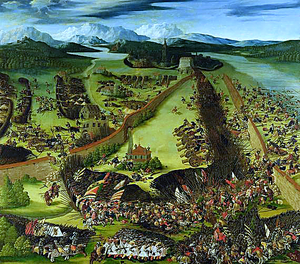Battle of Pavia
| Battle of Pavia | |||||||
|---|---|---|---|---|---|---|---|
| Part of the Italian War of 1521–26 | |||||||
 Ruprecht Heller, The Battle of Pavia (1529), Nationalmuseum, |
|||||||
|
|||||||
| Belligerents | |||||||
|
|
|||||||
| Commanders and leaders | |||||||
|
|
|
||||||
| Strength | |||||||
| 17,000 infantry 6,500 cavalry 53 guns |
19,000 infantry 4,000 cavalry 17 guns |
||||||
| Casualties and losses | |||||||
| 15,000 dead, wounded or captured | 500 dead or wounded | ||||||
The Battle of Pavia, fought on the morning of 24 February 1525, was the decisive engagement of the Italian War of 1521–26.
An Imperial–Spanish army under the nominal command of Charles de Lannoy (and working in conjunction with the garrison of Pavia, commanded by Antonio de Leyva) attacked the French army under the personal command of Francis I of France in the great hunting preserve of Mirabello outside the city walls. In the four-hour battle, the French army was split and defeated in detail. The French suffered massive casualties, including many of the chief nobles of France. Francis himself was captured by Habsburg troops and imprisoned by Charles V and forced to sign the humiliating Treaty of Madrid, surrendering significant territory to his captor. The outcome of the battle cemented Habsburg ascendancy in Italy.
The French, in possession of Lombardy at the start of the Italian War of 1521–26, had been forced to abandon it after their defeat at the Battle of Bicocca in 1522. Determined to regain it, Francis ordered an invasion of the region in late 1523, under the command of Guillaume Gouffier, Seigneur de Bonnivet; but Bonnivet was defeated by Imperial troops at the Battle of the Sesia and forced to withdraw to France.
...
Wikipedia
